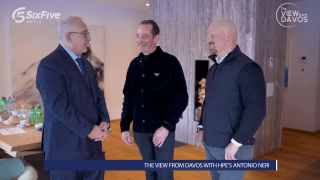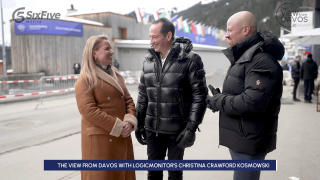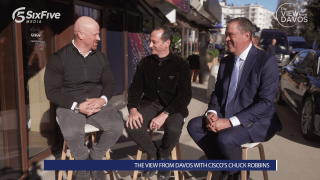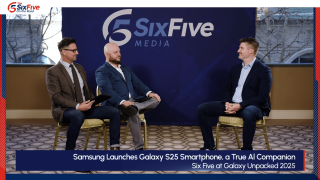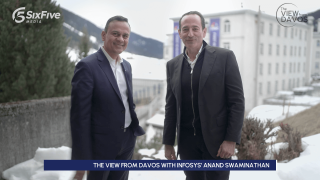AI PCs for CTOs: Join Six Five On the Road for the final episode of our four-part series with Intel. Patrick Moorhead and Daniel Newman are joined by Intel‘s Todd Lewellen, VP & GM of PC Ecosystem, and Daryl Cromer, VP & CTO of PCs and Smart Devices at Lenovo for a conversation on the transformative impact of AI on enterprise computing.
Their discussion covers:
- The evolving role of AI in enhancing PC capabilities and user experience
- Strategic partnerships between Intel and Lenovo to innovate in the AI PC market
- Key trends and future outlook for AI technologies in enterprise computing environments
- Challenges and opportunities in integrating AI within existing PC ecosystems
- Insights into upcoming AI features and functionalities in PCs and smart devices
Learn more at Intel and Lenovo.
Watch the video below at Six Five Media, and be sure to subscribe to our YouTube channel, so you never miss an episode.
Or listen to the audio here:
Disclaimer: Six Five On the Road is for information and entertainment purposes only. Over the course of this webcast, we may talk about companies that are publicly traded and we may even reference that fact and their equity share price, but please do not take anything that we say as a recommendation about what you should do with your investment dollars. We are not investment advisors, and we ask that you do not treat us as such.
Transcript:
Patrick Moorhead: The Six Five is On the Road here at Intel corporate headquarters here in Silicon Valley, and Dan, we are talking about our favorite topic and that is artificial intelligence.
Daniel Newman: Yeah, I always feel like you’re queuing me up, but then-
Patrick Moorhead: Well, I kind of am.
Daniel Newman: Then you go ahead and just finish the sentence.
Patrick Moorhead: Go ahead, Dan.
Daniel Newman: Yeah, look, we are going to be talking about this a lot, and I know some of the rhetoric out there is, “Oh, there’s just so much enthusiasm and excitement, and is it a real thing?” And I hope they’ll listen to us. We’ve been paying attention to this, not only for the last two years since the advent of ChatGPT and all that enthusiasm, but for the last four decades. You’ve been probably for four decades. I haven’t been alive that long. But we’ve been paying attention to these trends and this is a big trend. And what we have hit, Pat, is the inflection point. We’ve hit the inflection point where we’ve gone from, “This is cool, this could change something. This might be impactful,” to, “This makes sense.” The applications are there. We’re going to start using them. We’re going to produce value and we’re going to change lives. We’re going to change people’s lives, the way they work, the way they interact, the way they communicate.” It’s really exciting.
Patrick Moorhead: Yeah, and the other shift we’ve seen too, in terms of the dialogue and the focus, is this was a data center conversation only.
Daniel Newman: Right. Yeah, it started there, for sure.
Patrick Moorhead: Exactly. And what’s evident and super exciting and we’ve seen with all technology transitions, it starts in the data center and then it moved to the end point. And again, AI PCs are here. I was on Intel’s stage in January at CES announcing the Core Ultra with them and their biggest customers, and it was a lot of fun. It really set the stage for what could be potential for the future and true value. And we’ve been talking a lot in this series. We’ve gotten the CIO viewpoint, we’ve seen the procurement viewpoint, we’ve seen endpoint management viewpoint, but we haven’t hit the CTO viewpoint.
Daniel Newman: And of course, if you haven’t checked all of them out, I hope everyone out there clicks through them, because we do have a whole series here. But Pat, I do also want to point out that people should probably find that CES moment, because you wore a sweater that deserves recognition.
Patrick Moorhead: It is, yes. I was mocked incessantly for what I wore on the, come on.
Daniel Newman: You’ve got to imagine the biggest fuzziest sweater.
Patrick Moorhead: Can we get to our guests here?
Daniel Newman: We can.
Patrick Moorhead: Oh, what do you think?
Daniel Newman: Let’s do it.
Patrick Moorhead: No. Darryl and Todd, welcome to The Six Five. Great to see you.
Daryl Cromer: Thank you. Glad to be here.
Todd Lewellen: Thanks for having us.
Daniel Newman: Darryl. It’s great to have you here. Pat and I both have spent a lot of time with both Lenovo and Intel during this period, before this period as well. And it’s been great to see the innovation, watch the innovation. I can tell you, I think I tweeted something just recently about the 30-
Patrick Moorhead: That’s shock.
Daniel Newman: … laptop, I know I tweet a lot. But the 30 laptops that sit in my office and I play with all of them. And Lenovo has some great designs and I’ve really enjoyed some of the new ones as well. I’m looking for that CTO lens. You’re part of a company that’s building, but you’re also probably thinking about how to even use it within Lenovo. Talk a little bit about this AI PC inflection.
Daryl Cromer: I think a comment you made previously was we’re talking about for 40 years. I remember being in grad school, we’re talking about neural networks and what are they going to be and now we have them on our desktop, so we think about that. What it has done is transformed our capabilities. So if I look back at opportunities, we see in the industry there’s some mega shifts that occurred. We brought the internet into the device, wireless, we unchanged it from the desktop, how we moved into a cloud hybrid ecosystem. This is going to be another one of those inflection points.
And I don’t think we can stress enough how it’s going to transform how we do our work, our workflows, our efficiency, our productivity. But the thing that I find most exciting about it is today a lot of the work we do, it makes me more productive. This makes me smarter. It’s a logic and reasoning capability. So it can extend my capabilities beyond what I have, which is something that’s different as on wants to figure out how to take advantage of that and unleash that to be more productive, more convenient, more intuitive, easier to use, but also raise the capabilities of the workers. That’s going to be huge transformative. As we capture that and unleash that power, it’s going to significantly transform our industry and transform the world, as you said, every aspect.
Patrick Moorhead: No, I love that. And the first thing that comes into my mind is like a superhero and these… It’d be great if these new class of PCs really supercharge each and every worker and give them essential… I know it sounds a little bit like a marketing thing, but having used the technology, I mean, it’s there and it is going to happen. It’s clearer than I think any major transition that I’ve seen over the last 30 years.
Daryl Cromer: We talk about being superhuman capabilities and for example, English is not my strong point, writing, and I can do grammar correction and spell correction, but this allows me to do phrasing and bring in capabilities I hadn’t thought of and position it where suddenly what I output becomes significantly more impactful because I can write like a poet, a noble.
Daniel Newman: I love this. Sounds like me too where it can get to know you and, AI.
Daryl Cromer: Yeah, the personalization that comes through versus grammar understands my dialect, the phrases I use, that personalization aspect is huge. So we look at this, it’s going to give the ability for each of us and the companies to really transform. And the challenge that comes into making sure we know how to release it and let our employees drive it and really encourage it because with any new technology, a little bit of a timeframe to get comfortable with it. But then there’s also the ability to figure out how to unleash it in the best way possible. And this is incredible.
Patrick Moorhead: So Todd, Intel is a major enabler of PCs. It’s been a major enabler for AI PCs. What are some of the specific features and functionalities in this new wave of AI PCs that you believe will help businesses the most?
Todd Lewellen: Yeah, I mean, I tend to break it into a couple of buckets. The first being these are just better machines.
Daryl Cromer: Yes.
Todd Lewellen: You’ve got three engines. You’ve got the ability to do tasks faster. We see content creator apps that are using all three engines in parallel to complete their work.
Patrick Moorhead: GPU, NPU.
Todd Lewellen: You got it.
Patrick Moorhead: Okay.
Todd Lewellen: Yep, you got it.
Daniel Newman: Good job.
Todd Lewellen: You got video collab apps that are moving workloads off of the CPU, freeing up an entire core for other work, so you can move it over to the NPU and reduce your power consumption. Better battery life. You got better security apps that are now running locally on your client on the NPU. So better battery life, better performance, lower cost, lower latency. That’s kind of bucket A.
But like you were saying, Daryl, I’ll give you an example of what we’re doing internally right now. We have a pilot we’re doing, and we have, in this case it’s the product support team for the field. And this product support person, we took an LLM, they then married all these product docs, thousands of pages of product information because they answer field calls all day long with product questions. We married the two and this person built their own AI assistant. Two months later, he says, “I can answer 10 X the number of calls or inquiries a week, and I’m 90% more efficient.”
Patrick Moorhead: It’s right on the device itself.
Todd Lewellen: On the device, an assistant that’s what I call purpose-built for his role, product support specialist, answers questions all day. That’s what we’re trying to do more of a scale as we go forward.
Daniel Newman: You do a industry technology analyst?
Todd Lewellen: No, Dan, come on, virtual Dan.
Daniel Newman: You know that in teams a little raise my hand. Can we do this? The Dan bot experience? Oh wait, we could call it a “Danalyst”.
Patrick Moorhead: Oh, stop that.
Daniel Newman: So let’s talk a little bit about the AI PC and its influence though on the design. We’ve got a next wave of innovation around software design, around application development. Mobile created a wave of this. It went from mobile and then trying to create these experiences on the device. Is this that moment that happens or what are the other iterations that are happening in the more disruptive innovations in those particular spaces?
Todd Lewellen: Yeah, what’s been so exciting is just, and we’ve just seen it now, which is you get hardware out into the market and you just let the software community go crazy. And we haven’t seen it like this for years. And so I’ll give you an example. Just a few months ago, we had like 30 AI workload features running on the NPU. We now have over 130 AI features running on the NPU. And it’s because of 100, 200 ISVs that are just going crazy now because they’ve got all this capability at their fingertips, it enables them to go innovate. And that’s what we want. We want to just keep putting out more and more PTOPS in these platforms, let the software community go do their thing.
Daryl Cromer: And I totally agree, because it’s the innovation of the ecosystem that drives it. And this is what’s really going to change those workloads, those workflows, and really enable this. So as you create great parts, we are creating great products to bring that forward. And then enabling with our whole stack view from the pocket to the cloud, enabling that because we see as a whole ecosystem, it’s going to be very transformative. And I totally agree. Just unleash the power, give new capabilities.
Patrick Moorhead: So Daryl, as CTO at the Lenovo device group, you play a couple of roles here. And one of those is you get put in front of other enterprise CTOs for the business side of your business. And I’m curious, what are some of the conversations or recommendations that you’re making or maybe ideating with other CTOs on how it can help them get a competitive advantage in their business?
Daryl Cromer: Certainly. I think it goes back to very much the basics. Because what they’re looking for is how to have business value return today. So there’s that element. So you identify opportunities where it can really increase their productivity today, capabilities, whether it’s rewriting or proofreading or emails drafting, contesting, you talked about this. A great example of changing the workflow in terms of doing search for field issues, huge opportunity. One that I’m very passionate about is in the design, this notion of text to image creation. We’re talking with our designers at Lenovo and their ability has significantly improved because before, to go off and render and create something takes time. Now what they took days or weeks they can do in minutes and make that transformation because at the end of the day you’re going to say, “Well, I’d love to do this if I had more time.”
You now have more and more time and you can really expand your world, your imagination. You think about how companies have moved, media went from print to pictures to video to streaming. Now the ability to create much richer content is going to be brought down to a much lower level at every level. So I think you’ll see how companies present, market, plan, design be totally transformed through this great capability. And the neat part about it’s going to be on their desktop. So it’s secure, it’s private, they can drive that. It will just continue to unleash as it moves forward.
Daniel Newman: Yeah, it’s really exciting times. All the things that we’re going to be able to do with The Six Five will be really powerful. I have to ask you, this is going to be the hard question. You ready?
Daryl Cromer: Sure.
Daniel Newman: All right, so this inflection to the AI PC, if you’re asking the market, there’s a, is there enough, is there enough benefit? Is there enough battery life? Is there enough new application? Is there enough productivity to be gained? Daryl, you’re sitting in the seat, you’re trying to not only roll it out in your enterprise and help roll it out as the technology leader, you’re also trying to build products that are going to go to market. Are we at that point? Do you stand behind it? Is the market ready for the AI PC?
Daryl Cromer: The market is ready for the AI PC. You think about replacement cycles. If you’re going to buy a new PC today, you’re going to have that for three or four years. You may not need it tomorrow, but you will next year. So going forward, you have to be future-proofing. As we talked about the ecosystems coming forward we will see this over time, the software will get better, the hardware will get more powerful and we’ll address those issues. But today, there are use cases out there through our partners, Copilot for example. You can get real value today.
And we see this year getting into double digits. But we see that expanding dramatically the next three years of well over 50%, 60% of the market because we see that people have recognized this. This is a case where customers are asking us how can we use it? It’s not me trying to tell them you need it. It’s a totally different view. So our job is very simple, great parts, great products, great enablement, and let the ecosystem drive.
Daniel Newman: That’s right. So Todd, I’d love to get you to answer that one for me then. Are you ready? I mean, of course is Intel, you’re not going to be like, don’t buy my, but I think you also have to be great partner, great advisor. And part of that is always balancing the getting it right when, and what I’m sensing from these conversations is you think the right time is now.
Todd Lewellen: Yeah, absolutely. I’m just going to reiterate what Daryl said, “You’re going to want to start now.” And like you said, if it’s a year from now, you need to have the right hardware to take advantage of all these new applications and experiences that are coming. You don’t want to be the one that’s your fleet has CPU, GPU only, and I can’t get this particular performance or this experience and this productivity gain. So it is about getting started.
Patrick Moorhead: Well, it makes a lot of sense too. I mean, historically there were two classes of PCs before the internet. There were ones that could do the internet and then there were ones that couldn’t. Those enterprises that bought PCs that couldn’t do the internet were basically boat anchors, because everybody wanted to jump on it as soon as the internet was turned on inside of the enterprise. I see a very similar historical example of people who were left behind and obviously we’ve seen transitions in consumers, there were non-multimedia and multimedia, but it seems like more than ever enterprises, if they think they’re going to have their PCs, by the way, three to four is generous, it’s four to five. If you think there’s going to be value there, you need to be investing in that now. Does that make sense?
Todd Lewellen: Spot on. Okay, spot on.
Daryl Cromer: But I do want to mention there are applications today. We have the creative zone, we have AI now that’s available. So you can start using this and getting value today and learning so that you’ll be ready and understand how to change your business versus waiting and looking back at, oh, my competitor made the transformation, I’m behind. So the message is embrace it, work on it, get engaged now because it will change. You do not want to be left behind.
Daniel Newman: Like all technology, it can do a lot of things now and you can be sure if it’s not doing what you want, just wait and it will come. Appreciate both of you. Daryl, Todd, thank you for joining us here on The Six Five.
Daryl Cromer: Thanks you guys.
Todd Lewellen: Thank you. It’s been a pleasure.
Daniel Newman: And thank all of you for taking the time to be with us here. We are at Intel corporate headquarters in beautiful Santa Clara, California for The Six Five. For Patrick Moorhead and myself, we got to sign off and say goodbye. Thanks for being part of our community. We’ll see you all really soon.


